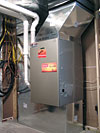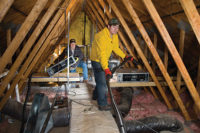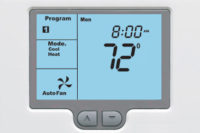THE MOTHER OF INVENTION
The whole problem can be traced back, said Skog, to the government mandate that required manufacturers to make 13 or higher SEER air conditioning units, which require taller coils than previous units.Due to the extra height needed for these new coils, it turned out to be quite a challenge for Crosslake Sheetmetal to install a furnace and all the equipment - A coils, an electric plenum heater, zoning - in low-ceiling applications, such as in some basements, in the upflow position. Adding to that challenge was the need to install everything in such a way, said Skog, “that it still followed the manufacturer’s guidelines as to spacing for sensors and things of this nature.”
So whether it was in “retrofit-replacement or new construction, we were running out of room in upflow applications.”
To overcome this spacing problem while meeting Bryant’s guidelines (Crosslake Sheetmetal is a Bryant dealer), the counter flow box was conceived and designed.

In an installation such as a new construction application, where a furnace is being installed in a space with a low ceiling, use of the counter flow box makes fitting in the furnace and other equipment easier by allowing the furnace to be installed in the counter flow position.
HOW IT WORKS
Instead of trying to install a furnace and other equipment in this sort of situation in the upflow position, according to Skog, the counter flow box permits a furnace to be installed in the counter flow position. The filter is at the top of the furnace, and the furnace is on top of the counter flow box. The box is in the shape of a horseshoe, directing air back up, where it can go through the coil, zone dampers, and an adequate supply plenum.Skog described the counter flow box as “a platform, which the furnace is placed on, but it has a series of turning vanes on the supply side.” It decreases the airflow pressure drop through it and spreads the airflow out for the coil, the plenum heater, etc.
“It gains us another 20-30 inches in height to allow us to get our A coils, our plenum heaters, zoning, discharge sensors, all of this stuff put together in a fashion that still is under the guidelines of the manufacturer without trying to cram it all in and then have service issues later on down the line.”
One of the first applications where a counter flow box was installed was in October 2006, and Crosslake Sheetmetal now installs it in about 50 percent of its residential installations.
Skog has nothing but praise for the counter flow box and how it performs in the field. “I’d honestly have to say we had nothing but positive results with it,” he said. “It’s maybe a situation that this application takes up a little bit more floor space than a normal upflow installation, but we’re talking additional space of maybe 10-12 inches in width. That’s the only thing, that it takes up a little more space.”

The counter flow box shows the built-in turning vanes.
INTERESTED PARTIES
Skog is a current member of Bryant’s Partners In Development (PID) group, which is a band of up to 12 dealers who help Bryant with product development. He presented the counter flow box to the group, which expressed an interest in it, as have other dealers. Skog is glad to have other contractors interested in the counter flow box.“It’s just one way to overcome these tall coils. To share it with other people, I have no problem with it because it saves us time and service headaches in the future by using it. If someone else can use it, by all means they should be doing it.”
Sidebar: A Close-Up of Crosslake
Located in Crosslake, Minn., Crosslake Sheetmetal performs approximately 80-85 percent residential work and the rest is light commercial. The company offers 24/7/365 service. According to the owner, Karl Skog, priority service agreements are offered and so the company is “big into preventive maintenance.”In addition to installation and service, Crosslake Sheetmetal also does light manufacturing, producing its own ductwork, etc.
The company employs a total of 21 employees, including three full-time service techs and a full-time gas fitter.
Publication date:01/12/2009




Report Abusive Comment